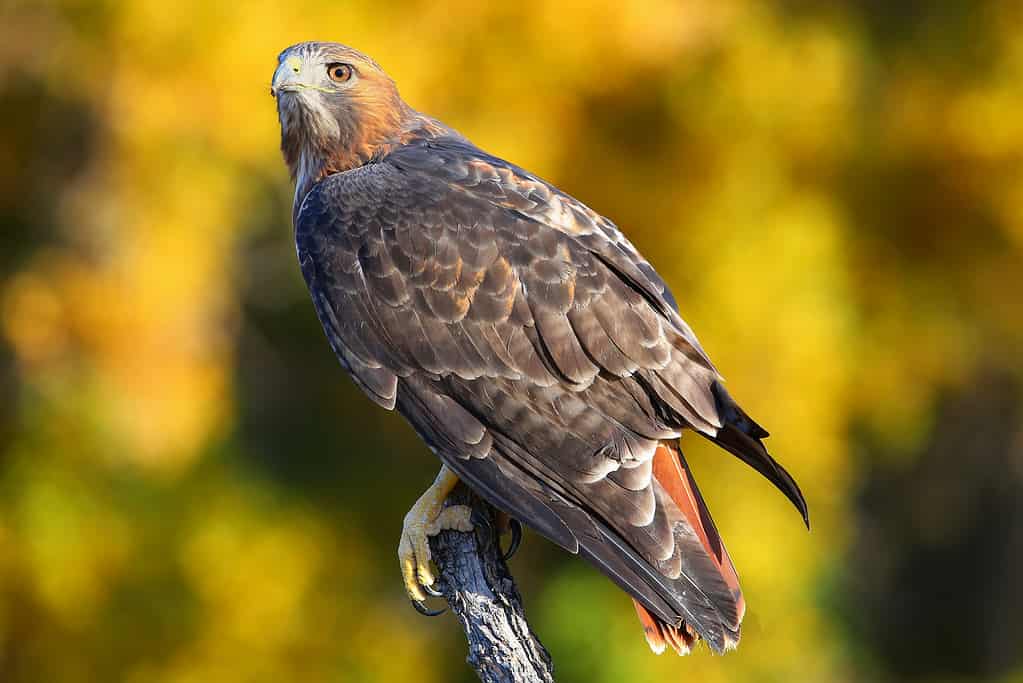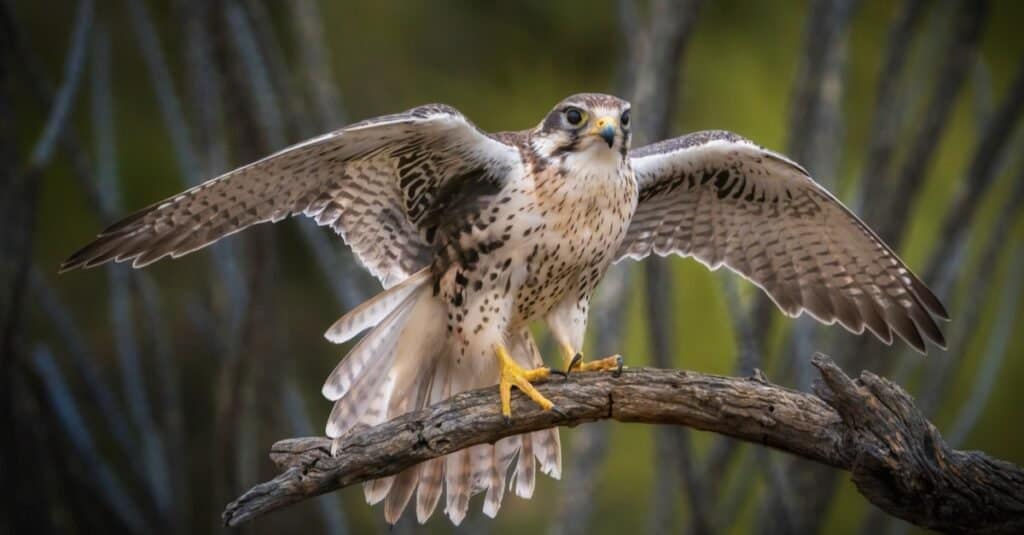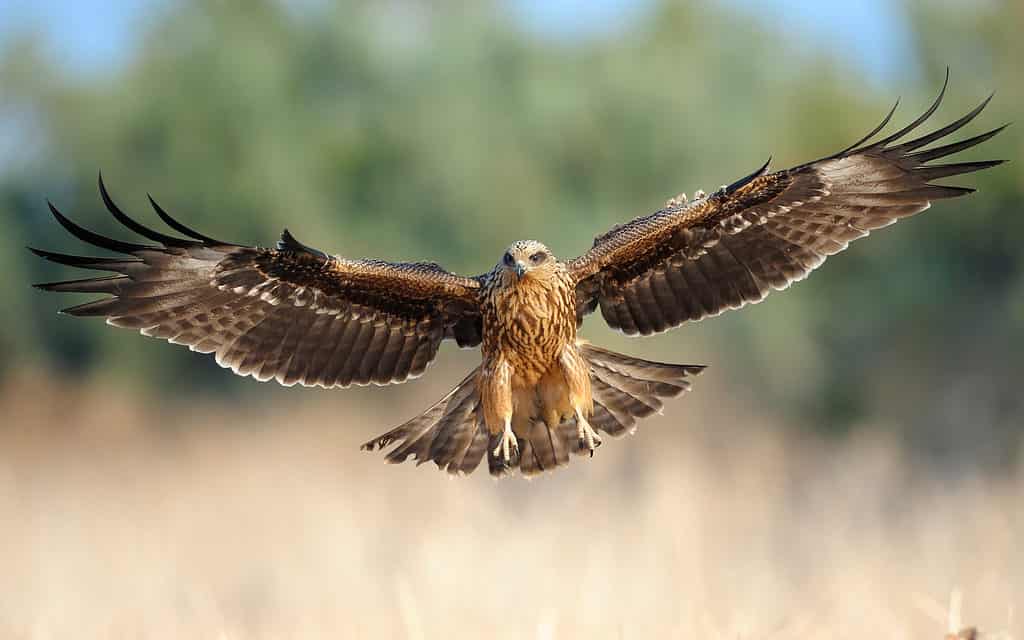With their beautiful appearance and strong stature, eagles are a captivating sight to behold in the world of avian species. Their piercing eyes, mighty wings, and sharp talons evoke a sense of admiration from bird lovers and casual observers alike. However, it’s not uncommon for individuals to mistake other birds that look like eagles due to some similar physical characteristics or behavioral traits.
In this article, we will venture into the realm of birds that look like eagles. Specifically, we will examine an array of bird species that are often confused with their more illustrious kin. We will unveil the subtle distinctions that set these birds apart, helping you better to discern these fascinating feathered creatures from their soaring counterparts.

Red-Tailed Hawk (Buteo jamaicensis)

Red-tailed hawks share sharp, hooked beaks and piercing eyes making them one of the top birds that look like eagles.
©iStock.com/Donyanedomam
The red-tailed hawk, a bird species often confused with eagles, shares similarities that can easily lead to misidentification. This magnificent raptor has an impressive wingspan and a striking appearance, contributing to the mix-up with their eagle kin. Characterized by a robust build and a distinctive rusty-red tail, the red-tailed hawk showcases a strong presence in the skies.
In terms of appearance, both eagles and red-tailed hawks exhibit an assertive, regal demeanor, with sharp, hooked beaks and piercing eyes. Their expansive wings facilitate smooth sailing across the skies, and their powerful claws are designed for seizing their quarry. This uncanny similarity often causes a case of mistaken identity for those less familiar with the subtle nuances that differentiate the two species.
Both birds share a liking for eating a variety of small mammals, birds, and reptiles. As efficient predators, they employ their keen eyesight and hunting prowess to locate and capture their quarry. Though they may have overlapping preferences regarding food sources, the larger size of eagles usually allows them to tackle more critical prey items than their red-tailed hawk counterparts.
The red-tailed hawk and the eagle can occupy various environments across North America. They are known to inhabit forests, grasslands, and even urban areas, as long as there is access to prey to support their dietary needs. They favor high perches such as trees or electricity poles, which provide a good vantage point to survey their surroundings and look for any potential prey.
How To Spot The Difference
Size is an obvious difference between these two species. Eagles are bigger, with a larger wingspan, while red-tailed hawks are smaller. Eagles have a more robust appearance, characterized by broader wings and a proportionately larger head relative to their body size. Red-tailed hawks, on the other hand, possess narrower wings and smaller heads, giving them a more streamlined appearance.
Eagles are easily identified by their white head and tail feathers, contrasting with their darker brown body. Juvenile eagles, however, can be harder to recognize, as their heads and tails start out brown and slowly turn white as they mature. Red-tailed hawks are known for their signature reddish-brown tail, often more visible in flight. Their body color varies, but they generally have a brown back and a lighter, streaked underside.
In flight, eagles often soar with their wings straight out, while red-tailed hawks often hold their wings in a slight dihedral (V-shape) and glide more often. Moreover, eagles tend to have a slower, more deliberate wingbeat, while hawks display a faster wingbeat.
Eagles and red-tailed hawks inhabit various locations across North America, but their preferred habitats differ. Bald eagles are often found near water bodies, as their primary food source is fish. Conversely, red-tailed hawks occupy a broader range of habitats, including forests, grasslands, and urban areas.
Turkey Vultures (Cathartes aura)

A turkey vulture’s massive size and wing span make it easy to mistake for an eagle.
©GarySang/Shutterstock.com
Turkey vultures and eagles share some similarities as they are both large birds of prey, making it easy to confuse one for the other at first glance. In terms of appearance, turkey vultures boast a wingspan of around 65 to 70 inches, comparable to some eagle species. Both birds exhibit dark plumage. In addition, turkey vultures have red, featherless heads.
Both turkey vultures and eagles are carnivorous but differ in their hunting and feeding habits. But both species have excellent vision, which they use to locate prey or carrion from high areas. Furthermore, turkey vultures and eagles are both capable of sustained soaring flight, which allows them to save energy while covering large distances.
Regarding their habitat, turkey vultures and eagles share a propensity for occupying various ecosystems. Turkey vultures can be found throughout the Americas in a wide range of habitats, including woodlands, savannas, arid regions, and even suburban neighborhoods. Eagles, too, are adaptable and occupy various environments, ranging from coastal areas and wetlands to forests and mountains. However, the exact habitats eagles prefer depend on the species in question.
How To Spot The Difference
Distinguishing between a turkey vulture and an eagle can be done by seeing critical differences in appearance, flight patterns, and behaviors.
Turkey vultures have a unique red, featherless head, starkly contrasting to the fully feathered heads of eagles. Their plumage also differs, with turkey vultures displaying a brownish tint to their feathers. On the other hand, eagles usually exhibit darker black or brown feathers, sometimes with white markings. The overall body shape of turkey vultures is less robust than eagles, with a smaller, more elongated form.
When watching their flight patterns, turkey vultures often soar with their wings in a distinctive V-shaped way. This characteristic allows them to glide effortlessly, riding on thermals while searching for dead prey. Eagles exhibit a more horizontal wing position when soaring, with some powerful wing beats to maintain their altitude.
Behaviorally, the feeding habits of these two birds set them apart. Turkey vultures feed on carrion, using their acute sense of smell to locate decomposing animals. They often circle over potential food sources or gather around carcasses on the ground. Conversely, eagles are active predators that hunt live prey, such as fish, mammals, and birds. They are known for their exceptional vision and powerful talons, which they use to snatch prey from land, water, or even from other birds mid-flight.
Prairie Falcon (Falco mexicanus)

Prairie Falcons are often mistaken as birds that look like eagles.
©JayPierstorff/Shutterstock.com
The prairie falcon is one of the birds that look like eagles. It is a medium-sized bird of prey that, at first glance, may appear similar to an eagle. The prairie falcon’s overall body shape, featuring a solid build and mighty wings, may look like an eagle’s.
In addition, the prairie falcon’s plumage is mostly sandy brown or grayish-brown with a lighter underside, somewhat similar to the color of certain eagle species. This resemblance is further accentuated by the dark marks around the eyes, which can evoke the facial features of some eagles.
Both prairie falcons and eagles are carnivorous predators. Prairie falcons hunt small mammals and birds, such as ground squirrels, pigeons, and passerines. They are agile and fast hunters, using their impressive speed and maneuverability to capture prey mid-air or on the ground. Eagles, too, are intense hunters, preying on various animals. However, their hunting techniques and preferred prey may differ based on the specific eagle species.
Prairie falcons are usually found in the western regions of North America, living in open landscapes such as grasslands, prairies, sagebrush steppes, and desert areas. Their habitat preference is similar to certain eagle species, like the golden eagle, which can also be found in open landscapes, including grasslands, deserts, and mountain regions. Prairie falcons and eagles are known for their adaptability, helping them to thrive in various environments.
How To Spot The Difference
In terms of size, prairie falcons are smaller than most eagles. They have a wingspan of around 3 to 3.5 feet (0.9 to 1.1 meters), while eagles possess a remarkably wider wingspan, depending on the species. This difference in size is a primary factor in telling these two similar birds apart.
When it comes to appearance, prairie falcons display sandy brown or grayish-brown plumage with a lighter underside. On the other hand, eagles often exhibit darker brown or black feathers, sometimes with white accents. Additionally, prairie falcons have unique dark marks around their eyes, which is not a characteristic of eagles. However, with that said, at a quick glance, those marks may make these birds look like eagles. The overall body shape of prairie falcons is more streamlined and slender than the robust and powerful build of eagles.
Prairie falcons and eagles differ in their hunting techniques and prey. Prairie falcons are agile and fast hunters, preying on small mammals and birds. They are known for their impressive speed and maneuverability, capturing prey mid-air or on the ground. Conversely, eagles tend to hunt larger prey. They rely on their powerful talons and exceptional vision to locate and snatch their prey, often using different hunting strategies depending on the species.
Another difference between these two distinct birds is that prairie falcons are known for their unique vocalizations, which are different from the calls of eagles. Prairie falcons produce a variety of vocalizations, including loud screeches and chattering calls during flight, while eagles have a characteristic high-pitched whistle or scream. These vocalizations can help distinguish between the two species, especially when these birds are flying in the sky.
Black Kite (Milvus migrans)

The Black Kite is similar to eagles, making it one of the birds that look like eagles.
©Vladimir Kogan Michael/Shutterstock.com
The black kite, a moderately sized raptor, has certain similarities to eagles, sometimes causing mix-ups between the two species. Black kites possess a wingspan of around 4 to 5 feet, smaller than most eagles but still significant. Their plumage is mostly dark brown, with lighter streaks on the head and neck, giving them a similar appearance to certain eagle species.
Black kites can be found in various environments, ranging from forests and wetlands to open grasslands and human areas. This adaptability is a trait shared with some eagles, also known to inhabit diverse landscapes, including forests, deserts, mountains, and coastal regions.
Black kites and eagles are both carnivorous. Black kites feed on small mammals, birds, reptiles, and carrion, often scavenging for food in addition to hunting. They are opportunistic feeders known to snatch food from other birds or forage near human settlements. Though both species are carnivorous, their hunting techniques and preferred prey vary, reflecting differences in their ecological roles.
How To Spot The Difference
While the black kite and the eagle share some similarities as birds of prey, they also exhibit distinct differences that can help distinguish one from the other. Generally, eagles are bigger and more powerful than black kites. Black kites have a more slender body shape compared to the muscular and robust build of eagles. Furthermore, black kites possess a distinct forked tail, which sets them apart from eagles, which usually have rounded or wedge-shaped tails.
While both black kites and eagles are predators, their preferred prey and hunting techniques differ greatly. Black kites mainly consume small mammals, avian species, reptiles, and carrion, often scavenging in conjunction with hunting. As opportunistic eaters, they seize food from other birds or forage near human communities. Eagles tend to prey on larger prey animals.
Another point to note is that eagles tend to be more solitary hunters, while black kites are often seen hunting and scavenging in groups. Finally, eagles often nest in remote, inaccessible locations, whereas black kites tend to nest in more accessible locations, such as trees in urban areas.
Summary of The 4 Birds That Look Like Eagles
Here are four birds that look just like eagles:
| Rank | Birds |
|---|---|
| 1 | Red-Tailed Hawk (Buteo jamaicensis) |
| 2 | Turkey Vultures (Cathartes aura) |
| 3 | Prairie Falcon (Falco mexicanus) |
| 4 | Black Kite (Milvus migrans) |
The photo featured at the top of this post is © iStock.com/Kandfoto
Thank you for reading! Have some feedback for us? Contact the AZ Animals editorial team.






